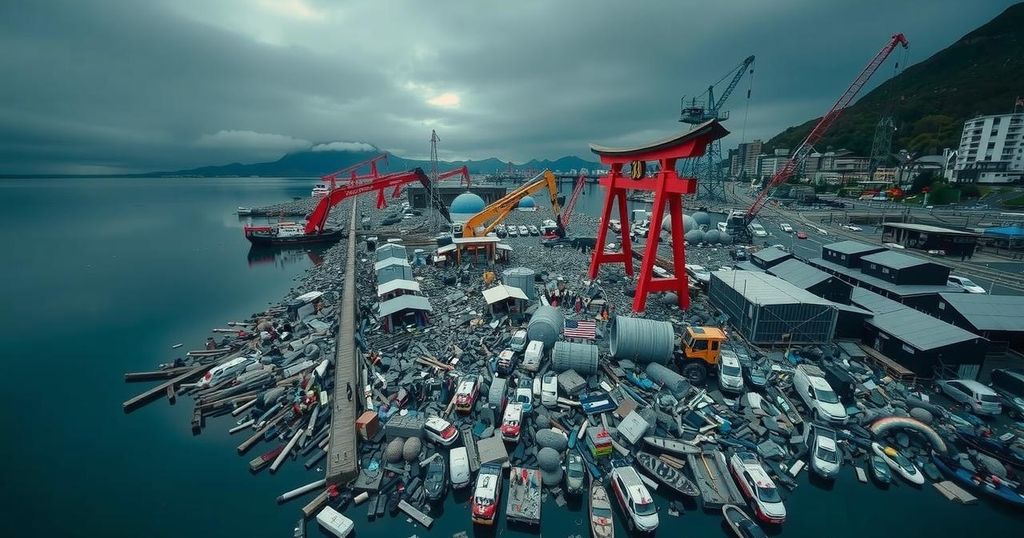Relief and Recovery Efforts Following the 2011 Japan Earthquake and Tsunami

The 2011 Tōhoku Earthquake and tsunami prompted an extensive relief and rebuilding operation, highlighting national and international efforts to rescue and support those affected. Rescue operations were complicated by adverse conditions, and many displaced individuals remained in temporary housing for years. The Japanese government initiated significant financial measures to ensure reconstruction, while efforts are ongoing to stabilize the affected areas and restore normalcy in communities.
Following the cataclysmic earthquake and subsequent tsunami that struck Japan on March 11, 2011, substantial relief and rebuilding efforts unfolded to address the devastation incurred. Prime Minister Naoto Kan promptly established an emergency command center in Tokyo and mobilized numerous rescue workers, including approximately 100,000 personnel from the Japanese Self-Defense Force. The government also sought assistance from U.S. military forces, resulting in the deployment of a U.S. Navy aircraft carrier to support relief operations. Several nations, among them Australia, China, India, New Zealand, South Korea, and the United States, dispatched search and rescue teams to aid in recovery. Additionally, international relief organizations such as the Red Cross and various private NGO initiatives were activated to provide financial and material support to Japan’s efforts. Challenges arose as rescue operations encountered significant obstacles including harsh weather conditions which hindered the logistics of personnel and supplies to the disaster zones. The scale of destruction presented a harrowing landscape; entire towns had been obliterated, leaving immense piles of debris and mud in their wake. In the immediate days post-disaster, while some survivors were rescued, a predominant focus was placed on recovering the deceased, many of whom washed ashore after being swept out to sea. Initial reports indicated that several hundred thousand individuals were residing in makeshift shelters with scant provisions of food and water, exacerbated by prolonged isolation for some survivors in the most severely affected regions. As fears mounted regarding the nuclear situation in Fukushima, the number of displaced persons rose dramatically. Within weeks, hundreds of thousands sought refuge away from the stricken areas, with significant portions still residing in temporary housing setups two years later. It was notable that, even four years post-tragedy, an estimated 230,000 individuals remained displaced, primarily due to the ongoing evacuation around the Fukushima plant. Though the infrastructure of northern Honshu began to see gradual restoration, challenges persisted. Power supply instability, stemming from Fukushima’s nuclear predicament, resulted in widespread power outages. Manufacturing output significantly declined as industries such as semiconductors and automobiles grappled with the disaster’s aftermath. Nonetheless, signs of recovery began to emerge by late summer 2011, with many enterprises resuming operations. By early 2012, industrial performance approximated pre-disaster levels. In response to the calamity, the Japanese government enacted three supplemental budgets for disaster recovery, culminating in a substantial budget of approximately $155 billion earmarked for reconstruction efforts. This included the establishment of a cabinet-level Reconstruction Agency in February 2012, tasked with overseeing redevelopment in Tōhoku for a projected decade-long restoration period. By 2015, reports indicated considerable progress with debris clearance and infrastructural projects, including the construction of coastal defenses and higher-ground sites designated for rebuilding, affirming a gradual yet steady recovery process for the region.
The earthquake that struck Japan on March 11, 2011, known as the Great East Japan Earthquake (or Tōhoku Earthquake), was one of the most powerful seismic events in recorded history. It triggered a massive tsunami that devastated extensive coastal areas, resulting in immense loss of life and property. The natural disaster compounded issues at the Fukushima Daiichi Nuclear Power Plant, leading to severe nuclear accidents. The aftermath necessitated extensive domestic and international relief efforts, as well as long-term recovery and rebuilding initiatives to restore the affected regions.
In summary, the aftermath of the 2011 Tōhoku Earthquake and tsunami unleashed a series of immediate and long-term challenges requiring vast relief and recovery efforts both domestically and internationally. The response involved significant mobilization of resources, international collaboration, and substantial government funding towards reconstruction, ultimately paving a path toward recovery in the affected areas despite the ongoing challenges post-disaster. Key infrastructures have been restored, yet a significant number of individuals remain affected by displacement due to the nuclear incident, emphasizing the lasting impact of this disaster on Japan.
Original Source: www.britannica.com







